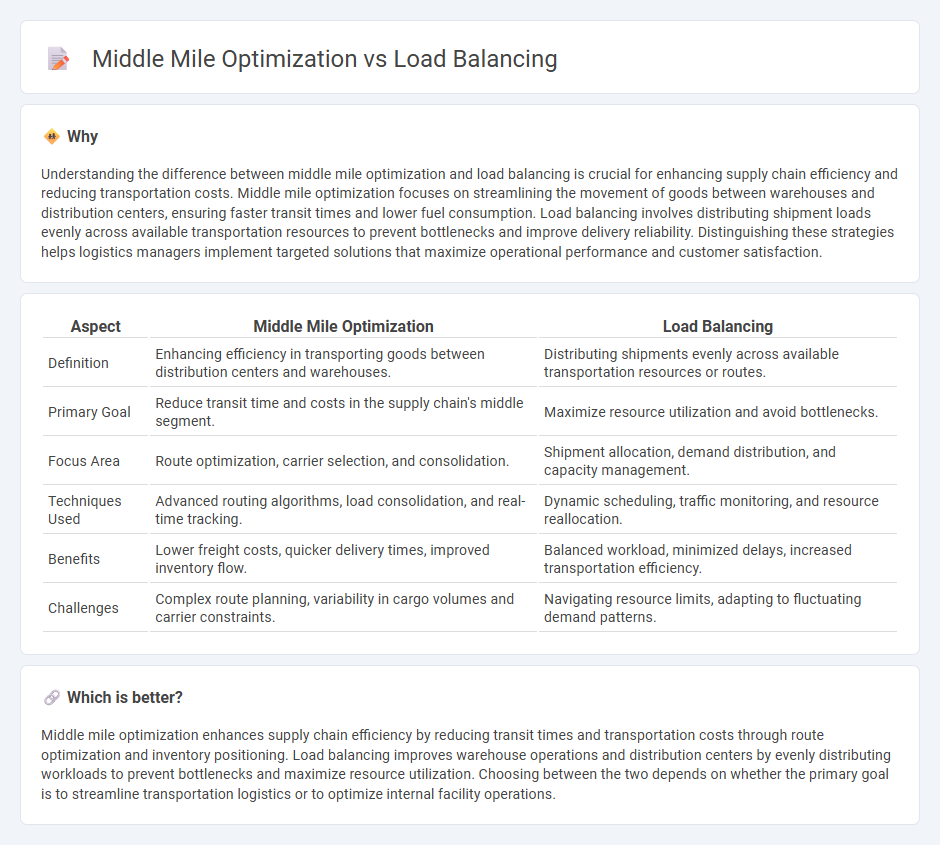
Middle mile optimization focuses on enhancing the efficiency and speed of goods movement between warehouses and distribution centers, reducing transit times and costs. Load balancing distributes shipments evenly across available transportation resources to prevent bottlenecks and improve overall network performance. Explore these strategies to optimize supply chain logistics and boost operational efficiency.
Why it is important
Understanding the difference between middle mile optimization and load balancing is crucial for enhancing supply chain efficiency and reducing transportation costs. Middle mile optimization focuses on streamlining the movement of goods between warehouses and distribution centers, ensuring faster transit times and lower fuel consumption. Load balancing involves distributing shipment loads evenly across available transportation resources to prevent bottlenecks and improve delivery reliability. Distinguishing these strategies helps logistics managers implement targeted solutions that maximize operational performance and customer satisfaction.
Comparison Table
| Aspect | Middle Mile Optimization | Load Balancing |
|---|---|---|
| Definition | Enhancing efficiency in transporting goods between distribution centers and warehouses. | Distributing shipments evenly across available transportation resources or routes. |
| Primary Goal | Reduce transit time and costs in the supply chain's middle segment. | Maximize resource utilization and avoid bottlenecks. |
| Focus Area | Route optimization, carrier selection, and consolidation. | Shipment allocation, demand distribution, and capacity management. |
| Techniques Used | Advanced routing algorithms, load consolidation, and real-time tracking. | Dynamic scheduling, traffic monitoring, and resource reallocation. |
| Benefits | Lower freight costs, quicker delivery times, improved inventory flow. | Balanced workload, minimized delays, increased transportation efficiency. |
| Challenges | Complex route planning, variability in cargo volumes and carrier constraints. | Navigating resource limits, adapting to fluctuating demand patterns. |
Which is better?
Middle mile optimization enhances supply chain efficiency by reducing transit times and transportation costs through route optimization and inventory positioning. Load balancing improves warehouse operations and distribution centers by evenly distributing workloads to prevent bottlenecks and maximize resource utilization. Choosing between the two depends on whether the primary goal is to streamline transportation logistics or to optimize internal facility operations.
Connection
Middle mile optimization enhances logistics efficiency by streamlining transportation between warehouses and distribution centers, directly impacting load balancing strategies that allocate freight evenly across available vehicles. Effective load balancing reduces transportation costs and delivery times by maximizing vehicle capacity and minimizing empty miles during the middle mile segment. Integrating these processes leverages data analytics and route optimization algorithms to synchronize cargo distribution with transit resources, improving overall supply chain performance.
Key Terms
**Load Balancing:**
Load balancing efficiently distributes network traffic across multiple servers to enhance application responsiveness and prevent overloads, ensuring high availability and reliability. It optimizes resource utilization and reduces downtime by dynamically managing incoming requests based on server performance and capacity. Explore in-depth strategies and technologies driving effective load balancing for improved network performance.
Resource Allocation
Load balancing efficiently distributes network traffic across multiple servers to optimize resource allocation, preventing overload and ensuring high availability. Middle mile optimization enhances data flow between core network points by reducing latency and improving bandwidth usage, indirectly supporting resource efficiency. Explore further strategies to maximize network performance through advanced resource allocation techniques.
Demand Forecasting
Demand forecasting enhances load balancing by predicting traffic patterns, enabling efficient distribution of network resources to meet user demand. Middle mile optimization leverages demand forecasts to streamline data routing and reduce latency between core and access networks, improving overall service quality. Explore our insights to understand how integrating demand forecasting transforms load balancing and middle mile strategies.
Source and External Links
Load balancing (computing) - Wikipedia - Load balancing is the process of distributing tasks over multiple computing resources to optimize processing efficiency and response time, using static or dynamic algorithms depending on system state.
What Is Load Balancing? | IBM - Load balancing distributes network traffic across multiple servers to enhance application availability and user experience, using hardware or software load balancers to route requests intelligently and avoid server overloads.
What is load balancing? | How load balancers work - Cloudflare - Load balancing, managed by hardware or software tools, allocates incoming traffic to servers based on algorithms that can be static or dynamic, ensuring better service performance and preventing individual servers from becoming bottlenecks.
 dowidth.com
dowidth.com